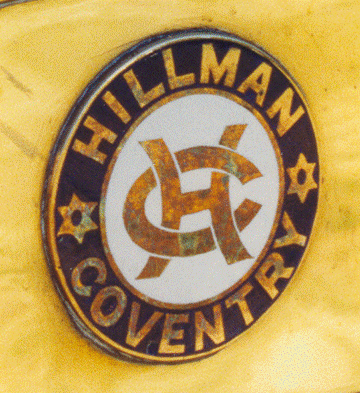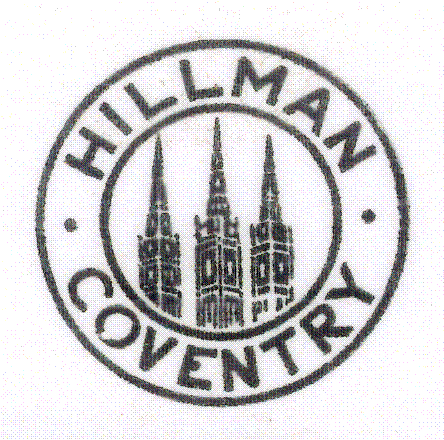HILLMAN CAR CLUB
OF SOUTH AUSTRALIA INC
 |
About the Hillman Marque |
HILLMAN CAR CLUB
OF SOUTH AUSTRALIA INC
 |
Brief summary
William Hillman and his son-in-law Louis Coatalen built the first Hillman motor car in Coventry, for participation in the 1907 T.T. race.
When Coatalen left in 1909, the Hillman Motor Car Company concentrated on producing small, well built, reliable vehicles such as the 8.9, 10 and 11
(RAC horsepower) models. In 1926, five years after Hillman’s death, the 14 h.p. model was produced under the watchful eyes of his sons-in-law
– Capt. Black and Spencer Wilkes. The success of this car led to the takeover by the Rootes Group in 1930 and the subsequent production of the
Hillman Minx in 1932. The Minx became the most popular model they produced – lasting for the next 40 years. While other larger 4 and 6
cyclinder models were produced over the years, and the Imp in 1963, the demise of the Hillman name came in 1976.
1907-1932 in more detail
from The Advertiser (Adelaide, SA), Tuesday 11 October 1932, page 7
HILLMAN'S Quarter Centenary
On June 6, Hillman Motor Car Co., Ltd., of Coventry, attained the 25th anniversary of its foundation, for it was on that date in 1907 that the late Mr. William Hillman, owner of the Auto-Machinery Co., of Coventry, formed the company which bears his name.
The object of this formation was solely for the purpose of entering the car which Mr. Hillman, in collaboration with Mr. Louis Coatalen, had designed, in the 1907 Isle of Man Tourist Trophy Race, and in spite of the fact that its production from the drawing board stage took only two months, it carried off the lap record at a speed exceeding 60 m.p.h. – an amazing performance at that time. As a result, orders were received for replicas of the car, and a small factory was built in Folly lane, Coventry.‡‡ The first Hillman models were four-cylinder cars of 25 h.p. R.A.C. rating and they rapidly established a reputation for sound, practical engineering which the Hillman Company has ever since successfully striven to maintain. The Hillman Company were, of course among the pioneers of the light car, and the 1912 9-h.p. model achieved remarkable success, being regarded as probably the soundest example of a type that was then something quite new. This model retained great popularity up to the outbreak of war, when the Hillman factory was, of course, turned over to the production of munitions. After the war, the 11.9 h.p. model was introduced, while in 1920 the Hillman Company initiated a departure which has been extensively copied – the listing of a sports model. Fitted with a very attractive polished aluminium body, the Hillman Sports Model carried off many of the “plums” of the motor sports world, including the coveted hour record for light cars at Brooklands, and during the 1920-21 season, secured more trophies than any other individual car at Brooklands. The 11.9 h.p. model had a long run of popularity until 1925, when it was supplanted by the Fourteen, and a little later the well-known Hillman Eight was introduced. The latest development of the 8-cylinder, namely, the Vortic, represents a degree of perfection to multi-cylinder motoring which has to be experienced to be believed. The year 1928 saw the amalgamation of the Hillman and Humber companies, following which the factory was completely reorganised, and much new machinery installed. The improvements to the plant paved the way for the famous Wizard, which was introduced at the historic Albert Hall gathering on April 27, 1931. This model speedily showed itself to be the type of car that appealed to motorists both at home and overseas, and in the comparatively short time which has elapsed it has achieved an extraordinary reputation for reliability and good service. The latest Hillman development – the Minx 10/30 h.p. light car – made its debut at the last Paris Salon, and deliveries have now been in progress for some time. The Minx bids fair to achieve an outstanding success in its class, for it is designed and built on lines which fit it for use in every country. It is a distinct advance in the construction of a type of car in which Great Britain has long specialised, at a price which is competitive in the extreme. The Hillman Company's 25th birthday, therefore, finds it In a strong position, producing models which are in entire accord with the most advanced automobile practice, and which are held in much esteem by motorists throughout the world.
‡‡ Folly Lane was the original name for Humber Road (not to be confused with Humber Avenue).
In this map, notice that Sunbeam Way
meets Humber Road at the roundabout. Notice also there, the Training & Technical Centre of PSA Peugeot Citroën – current owners of the Hillman,
Humber, Singer, Sunbeam, Commer & Karrier trademarks of the former Rootes Group.
Radiator Grille Badges
The first enamel badge was circular with the words “Hillman Coventry” around the perimeter and the letters HC in the centre.
In the 1920s before the introduction of the Minx, the well known “Wings” incorporating the spires of the 3 Coventry Cathedrals and just the
word “HILLMAN” was used.



For more detailed information about Hillman cars, please refer to this
Wikipedia article.
HOME page


